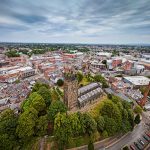Let’s be quite frank – Pontcysyllte Aqueduct is magnificent. We’re sure you’ve all admired it from a distance at one stage or another…it really is an incredible sight!
What’s not up for debate is that the official opening for this incredible feat of engineering took place on November 26, 1805. But…
What has been heavily debated is ‘who was the real brains behind the 1,007-foot long structure?’ This seems to have been narrowed down to four people.
We’ll attempt to see if we can solve the mystery…or at the very least uncover what each person contributed to the mammoth project.
The first name on our list is Thomas Telford. So we’ll take a good look at Mr Telford’s role, and try to fathom out whether he was indeed the ‘brains’ behind the aqueduct…
THESE TWO SIMPLE STEPS COULD TURN YOU INTO A RECYCLING SUPERHERO…
Thomas Telford
Once it had been decided to build the aqueduct in the 1790’s, Thomas Telford wrote to the canal company, proposing himself as “general agent, surveyor, engineer, architect and overlooker of the canal.” Nowadays ‘chief executive’ would have sufficed 😉
He had a strong background as a stonemason, architect and engineer, and the committee was so impressed that they accepted his offer.
Someone who was bitterly disappointed with this decision was William Turner (we’ll get to him later), who assumed he would have been appointed with the role himself. William Jessop, who had been acknowledged as ‘the most experienced canal engineer of his age’, was also disgruntled at the decision and felt that no one-man should have overall responsibility.
The appointment into this unique position and his seeming involvement in all aspects of the work gives Telford a valid claim to being the man responsible for the aqueduct. After all, he oversaw the entire project. But…
Did he design the aqueduct? Surely the ‘brains’ would be the person who sketched the plans and who this person was is still up for debate.
He certainly claims the designs as his own in his autobiography, but there aren’t signed drawings to back up his claim. And, as there was a large amount of delegation taking place throughout the project, who’s to say the actual design part wasn’t delegated too?
In his autobiography, he minimises William Jessop’s contributions when minutes from various meetings prove this to be otherwise. Is claiming the designs as his own also an exaggeration?
Possibly, but someone designed them and Telford claims the credit in his autobiography and is generally acknowledged historically as well.
Are you convinced? 😉 Let’s hear some of the other claims before we decide.
William Turner
Before Jessop was appointed, William Turner had already undertaken many surveys and was confident he would get the job as overlooker for the project. But it wasn’t to be.
Even so, if we are going to attribute any one-person to being the ‘brains’ behind the aqueduct, surely Turner could claim this as himself…after all he was there first, even if his work didn’t get beyond the survey stage.
The debate against Turner would be that a number of design changes took place over the course of the build, so the final outcome was far removed from his original proposals.
We suppose Turner can be credited for his part in the initial idea, but to acknowledge him as the overall ‘brains’ would be maybe too far-fetched.
On to the next…
William Jessop
Before Telford’s appointment, William Jessop’s contribution played a part in the initial stages of the project, acting in an advisory role to the local surveyors. Although he was never formally appointed, his status as “the leading canal engineer of his day” meant he was naturally the go-to person for such a large build.
In Telford’s written proposal to the canal company, he stated that any drawings would be “submitted to the consideration and correction of Mr Jessop”. Perhaps he knew that this would be key to his appointment.
It’s fair to say that Jessop was unhappy with Telford’s appointment, suggesting nobody could successfully undertake the entire direction of the engineering as well as the finances.
Despite his title suggesting that Telford would have the engineering responsibility, minutes from meetings made it clear that Jessop was the person responsible for advising the company about the best course of action. The minutes even refer to Jessop as ‘principal engineer’.
In Telford’s autobiography, he plays down Jessop’s role by only complementing him “in regard to earth work”.
There’s evidence to suggest that Jessop was delegated a number of tasks by Telford that certainly wouldn’t fall under the category of “earth work”, so perhaps this seems a little unfair.
As someone who was too modest to write an autobiography, we’ve never heard Jessop’s side in full.
Whatever you make of Telford’s assessment of Jessop’s, surely it can be said that the “the leading canal engineer of his day” played a big part in the concept for the aqueduct. And surely his role as a key consultant would give him a reasonable claim to being the ‘brains’ of the operation?
William Hazeldine
And finally Mr Hazeldine…
William Hazeldine was an experienced ironmaster and engineer whose support and skilful work was key to the project.
Much of Telford’s genius appears to be recognising people with ability and using their talents to the full – and Hazeldine certainly falls into this category. Telford valued him greatly and they worked together on many more projects over the years.
It appears that Hazeldine wrote the final specifications for the design of the iron trough for Pontcysyllte Aqueduct. He was a genius in his own field and even if he can’t claim the title of ‘brains’ of the project, his work was invaluable.
‘The brains’…
Based on these findings it would be harsh to single out just one person to this title. There were a lot of brains working simultaneously!
Thomas Telford deserves a great deal of credit for holding such a gigantic project together. It was an incredible success. And because of this, surely if anyone could claim to be the ‘brains’ behind it, perhaps it would be him.
But, his real success was to use the skills of many different people – more than mentioned in this blog, to get the project to completion. And therefore it’s only right to accept that there were many brains at work.
Pontcysyllte Aqueduct is magnificent…however it came about 🙂
For more information, please visit the Pontcysyllte Aqueduct World Heritage website.
How to become a recycling superhero…in two simple steps.
[button color=”” size=”large” type=”square_outlined” link=”https://news.wrexham.gov.uk/check-n-clean-and-love-your-leftovers-2-simple-recycling-tips-for-a-better-wrexham/”]GET RECYCLING TIPS [/button]










